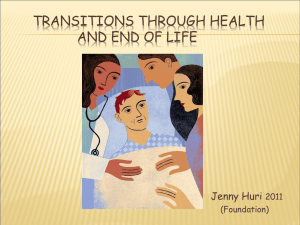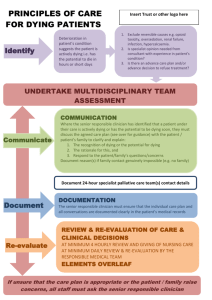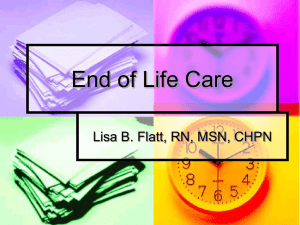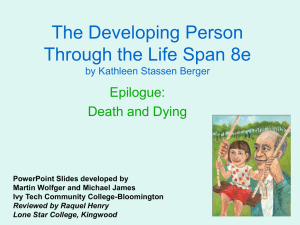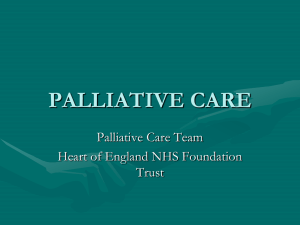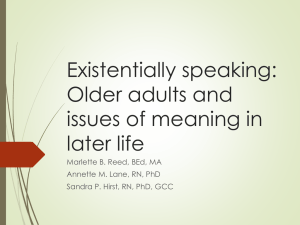PERRLA Version 6 For APA
advertisement
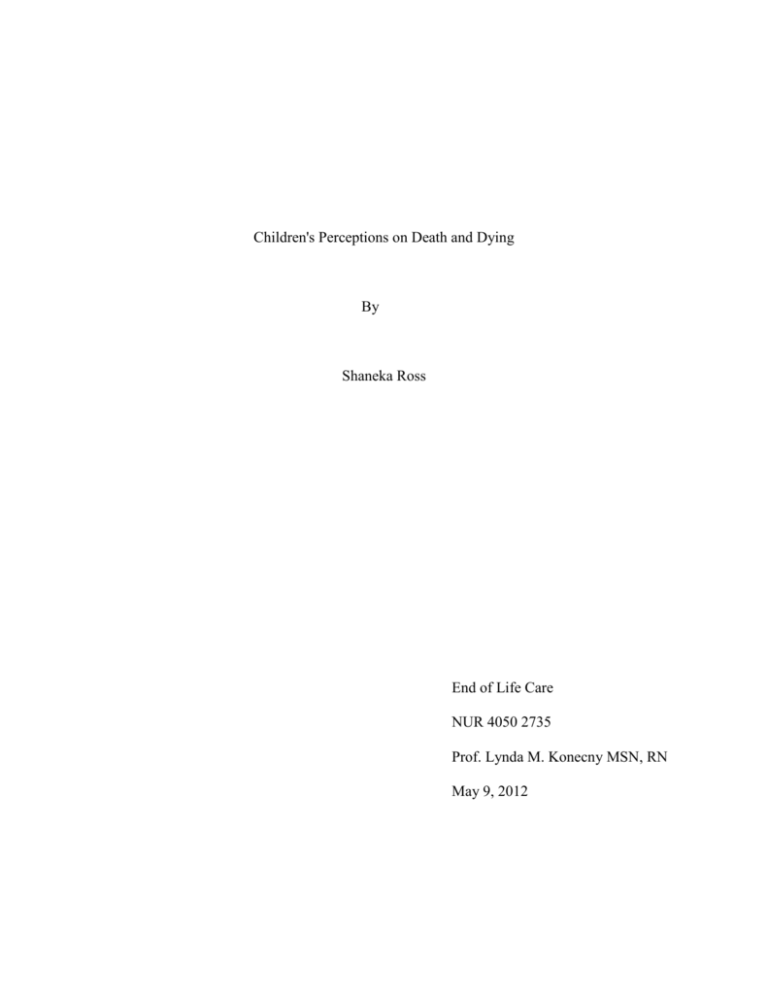
Children's Perceptions on Death and Dying By Shaneka Ross End of Life Care NUR 4050 2735 Prof. Lynda M. Konecny MSN, RN May 9, 2012 CHILDREN'S PERCEPTIONS ON DEATH AND DYING 2 Abstract Facing death is not an easy process for clients faced with terminal illness, with outcomes of nursing care impacting both the client and the family. Providing care for children at the end of life is considered to be the most difficult challenge for healthcare professionals. Children’s perceptions of death and dying are influenced by their stage of development and cognitive process, along with their ability to cope through a time of crisis. Nurses, therefore, need to be aware of how the needs of children differ from adults when providing palliative care. CHILDREN'S PERCEPTIONS ON DEATH AND DYING 3 Children's Perceptions on Death and Dying “A child’s conceptual understanding of his or her own illness is based not only on age and developmental level, but on the duration and type of experience accumulated with the disease” (Hockenberry & Wilson, 2009, p. 583). Individualized perceptions will determine how children cope with loss and grief, as this will be significant to the nursing care they are to receive. For nurses providing palliative care to children at the end of life, interventions must be tailored to include the dying child and family as a unit. There is a great deal of familial stressors when anticipating the death of a child. “Children represent health and hope, and their death calls into question the understanding of life……because it is out of the natural order of things” (Huckleberry & Wilson, 2009, p. 595). Children’s perceptions of death and dying are individualized and significantly relative to their stage of development. In addition, their perceptions can reflect the type of loss involved whether it is illness, death of a loved one or their own impending death. Also, relevant to their perceptions, are their cognitive abilities of abstract versus concrete thinking. “Children under the age of 2 usually have a sense of separation but little understanding of the concept of death” (Matzo & Sherman, 2010, p. 202). During early childhood, between the ages of 2 -5 years, children have some understanding of death and believe death is transient but not permanent. Because of their abstract thinking, children at this age associate death to a kind of sleep influenced by their magical thought process. In other instances, they can view death as a form of punishment. “They have no understanding of the universality and inevitability of death” (Hockenberry & Wilson, 2009, p. 598). School age children have higher cognitive abilities with a more concrete understanding of death. They do no think of death as something that will happen to them or anyone they know, CHILDREN'S PERCEPTIONS ON DEATH AND DYING 4 but they view death as a reality. Often at this stage of development their emotions and thoughts are incongruent. They may believe death can be influenced by the power of their thoughts, which can often cause bad things to happen (Goodman). School age children may even personify death as the devil, boogeyman or a monster. By age 9, they tend to have an adult concept; realizing death is universal and inevitable (Hockenberry & Wilson, 2009). By the time children reach adolescence, the realization of death is similar to adults and death anxiety becomes evident. It then becomes a natural part of development for these children to begin questioning their own mortality. Although the perceptions of death vary across the age-span, all children perceive death as a type of loss. Grief is defined as a normal reaction to the perception of loss and a natural form of healing (Matzo & Sherman, 2010). Children respond to grief based on their stage of development, individualized perceptions of their illness and their abilities to cope with loss. Generally, the initial signs of grief are evident nearing the sixth month when an infant develops an awareness of separation anxiety. Grief can also be exhibited as a response to parental anxiety and sadness. Growth and development can influence how children display grief, which are often times expressed through play and behavior. The clinical manifestations of grief displayed by children are classified as somatic, psychological and behavioral. “Children exhibit many of the grief reactions of adults, including physical sensations and illnesses, anger, guilt, sadness, loneliness, withdrawing, acting out, sleep disturbances, isolation and searching for meaning” (Hockenberry & Wilson, 2009, p. 606). Physical complaints may often include pain, fatigue, weight loss, hair loss, lightheadedness, diaphoresis, palpitations, constipation or diarrhea. Somatic complaints can be significant to CHILDREN'S PERCEPTIONS ON DEATH AND DYING 5 choking, feeling of something in the throat, sighing, sensation of butterflies in the stomach, shortness of breath and lack of muscle strength. During the end of life, the clinical manifestations of grief in children can represent their individualized coping mechanisms. In order to promote quality care and provide comfort to the family and dying child, interventions must be tailored to their stage of development, as well as, their presenting manifestations of grief. The primary goal for the nurse at this time is to decrease anxiety and promote a trusting relationship. Infants and toddlers may manifest grief with expressions of crying and irritability, a tendency to become less active (limp or lethargic) or less playful, a decreased appetite and sleep disturbances. During this stage of development, children have difficulty adjusting to change and response better to routine. Nursing care of children within this age group focuses on promoting primary nursing and maintaining routine to decrease anxiety. Including in routine care are providing comfort foods, such foods are often consistent with every meal (i.e. interest in only peanut-butter sandwiches). With preschoolers, grief can be manifested by behaviors such as giggling, joking, attention seeking, regression to earlier developmental stages or withdrawal and isolation (Hockenberry & Wilson, 2009). Other characteristics of grief are displayed through fighting, crying, tantrums and acting and talking as if the person is still alive (Goodman). Nurses should assure parents that the behavioral reactions of their children are normal, and an expected outward display of grief. A continuation of primary nursing care is essential to promote normalization. Minimize separation from parents to decrease anxiety and encourage them to have active participation in delivering care. Nurses should also encourage children to communicate grief verbally or actively through drawing pictures in order to decrease anxiety. CHILDREN'S PERCEPTIONS ON DEATH AND DYING 6 Early school age children, ages 6 -9 years, are more likely to exhibit grief through verbal, rather than physical uncooperativeness. Because they fear mutilation, they may be interested in what happens to their body. In Goodman’s article titled, “Children and Grief”, she highlights typical grief manifestations: anger, self-blame, mood swings, withdrawal, regression to earlier behaviors (i.e. bedwetting), lack of concentration, isolation and academic difficulty (Goodman). Middle school age children, ages 9-12 years, in addition to the aforementioned, may experience longing, concerns of physical health, resentment or sleep disturbances. These children may even suppress their emotions, and may only manifest grief through academic decline (Goodman). Nursing interventions during this developmental stage should include helping the child to acquire the developmental task of industry by allowing for independence. Allow them to participate in their care in order to maintain control over their bodies, and to develop a sense of self-worth and self-esteem in achieving their assigned developmental task. Encourage children of this age group to verbalize their feelings and provide aggressive outlets. Provide honest, simple and direct explanations of their illness to decrease their fears an allay anxiety. Most of all continue to keep family members involved in their care. Adolescents are more likely to display manifestations of grief equivalent to those displayed by adults. Goodman identifies some of these manifestations as numbing, anger resentment, anxiety, guilt, self-involvement, increased isolation, risk taking behaviors, selfinjurious behavior, decreased appetite, restlessness and verbalizations of fear of death (Goodman). In relation to their own illness, they may worry more about physical changes then their prognosis. Adolescents are more likely to exhibit physical and somatic complaints. Nursing management should include allowing the verbalization of their feeling and respecting their needs for privacy, solitude and expression of emotions. Promote parental communication while CHILDREN'S PERCEPTIONS ON DEATH AND DYING 7 avoiding alliances. Involve adolescents in their own care to maximize self-control and autonomy. Research has shown that nurse-client relationships have proven to be more effective when adolescents feel apart of their care and can independently contribute to medical decisions. Providing comfort and quality care at the end of life is a top priority for nurses providing hospice and palliative care services. During terminal illness, nurses should be aware of the essential aspects pertaining to caring for a child at end of life. Such aspects include pain and symptom management, communicating with the child, familial involvement, ethical considerations, and the type of setting in which the child receives their care. The quality of care received by the child will ultimately affect their ability to cope during this difficult time. Effective management and control of pain continues to be one of the most difficult aspects of caring for children at the end of life. A great deal of parental stress is based on the presumptions that often their child is suffering from pain. Depending on the developmental stage of children, pain can vary in presentation. Unrelieved pain in children not only presents physical affects, but it can result in psychological and behaviors impairments. Children can illustrate pain by crying, decreased appetite, irritability, changes in vital sounds and interrupted sleep patterns. Infants may present with many of the above behavioral responses in addition to physiological responses such as changes in vital signs, skin color, muscle tone. Metabolic changes such as low ph or hyperglycemia may also be evident, but these clinical manifestations can also be representative of their disease process. The subjectivity of pain is always difficult to assess during this time. Healthcare professionals evaluate behavioral patterns of children because they are the most significant identifier of a child’s pain level. Some commonly used tools for assessment are FLACC (Facial expression, Leg movement, Activity, Cry and Consolability) ranged on a scale CHILDREN'S PERCEPTIONS ON DEATH AND DYING 8 from 0 indicating no pain to 10 indicating the most possible pain behaviors. The Wong and Baker Faces Pain Rating Scale, is often used and consists of 6 faces ranging from smiling (no pain), to crying (worst pain). Such tools differ from those used in assessing adult pain levels because of the limited ability of children to verbally express discomfort. These tools are also measures to determine the type of intervention the child may need to receive. There a many pharmacological and non-pharmacological interventions nurses can implement when providing comfort at the end of life. Opioids are the most commonly used pharmacological intervention for pain control of children. Morphine, Dilaudid and Fentanyl are generally the drugs of choice and doses are adjusted according to age and weight. Nurses educated on providing pharmacological care to the dying child understand that occasionally, some children will require large doses of opioids as a result of tolerance or progression of the disease course. Care should be taken to explain that addiction should not be confused with tolerance and that pain control is the top priority. The successes of these interventions are dependent of the family’s understanding of the medication being administered and their active involvement in providing care. In addition to pain, other commonly experienced symptoms include fatigue, nausea and/or vomiting, constipation, anorexia, dyspnea, seizures anxiety, depression, agitation and confusion. Pharmacological treatment of stool softeners (i.e. Colace), anticonvulsants (i.e. Dilantin), antidepressants (i.e. Celexa), anxiolytics (i.e. Ativan) and corticosteroids (i.e. Solumedrol) may be included in their medication regimen. The listed examples are FDA approved pharmacological interventions that can be safely administered to children. Non- pharmacological interventions such as guided imagery, relaxation and therapeutic touch, massage, nutritive CHILDREN'S PERCEPTIONS ON DEATH AND DYING 9 sucking and musical or animal therapy can provide comfort for the child and improve their quality of life. “Hospice philosophy regards dying as a natural process and care of dying patients as including management of the physical, psychological, social, and spiritual needs of the patient and family” (Hockenberry & Wilson, 2009, p. 599). It is the responsibility, and the professional role of the nurse, to offer care that meets the needs of the family unit and provides supportive care and individualized coping. “Many barriers to providing optimal pediatric palliative care have been identified, including limited financial resources for specialized pediatric care, limited access to specialty care in rural areas, communication problems, false hope for cure, inappropriate continuation of use of advanced life-saving technology, ethical and legal issues, inappropriate eligibility criteria, fragmented care, inadequate assessment and management of symptoms, lack of research on pediatric palliative care, and lack of training and expertise” (Davies et al., 2008, p. 282). During end of life care, nurses must consider the dying child and their family as a unit. As healthcare professionals, they must be able to effectively communicate with parents, siblings and the client. Rarely are families prepared to deal with the loss of a child and coping with the decisions of end of life care. Often parents grieve from the loss of an imperfect child or added responsibilities pertaining to caring for a dying child. Nurses must explore the family’s perceptions of the dying child’s illness. Be empathetic, as this is a difficult time and the family may have an abundance of concerns. Actively listen to the family’s feeling and clarify any misconceptions. Many parents have concerns regarding pain and the management of their child symptoms. Nurses must educate the family on medication and treatments the child should be expected to receive. The family may also be concerned with the financial burden of caring for CHILDREN'S PERCEPTIONS ON DEATH AND DYING 10 their dying loved one. Care should also be taken to identify the roles of the members of the interdisciplinary team. Support services can be arranged to assist with the financial costs of end of life care. Family members should be encouraged to participate in the care of their dying loved one and be actively involve during the decision-making process. Nurses can also provide comfort to the family and their love one by creating an environment that is conducive to rending this information as respectively as possible. Assure that this information is provided with sensitivity and care. When a child is face with death, the role and responsibilities of family members change. Relationships may suffer and sibling may begin to act out, as they often feel isolated. The role of the nurse is to provide care for the family who presents with grief and suffering. During this time, nurses must be prepared to help family members understand the needs of their dying child and provide support to those actively involved in the child’s care. The most supportive measure nurses can give to the family is to just listen. Other interventions are relative to maintaining sibling involvement, alleviating caregiver role strain and preventing parental distress. Nurses should encourage family members to be involved during discussions, while actively listening to their concerns and fears, and providing information whenever necessary. Be attuned to their emotions and address them with compassion and empathy. Another important aspect for nurses to consider is offering the family anticipatory guidance during end of life care in order to help the family maintain structure. Mothers are often the primary care givers and fathers, the financial providers. Social isolation becomes evident and parents often times feel depressed, isolated and angry. Nurses should allow parents to discuss their feelings towards caring for a child at the end of life. Communicate to parents the availability of support groups to identify with others faced with similar situations. Parents should CHILDREN'S PERCEPTIONS ON DEATH AND DYING 11 be encouraged to develop supportive networks. Such support will give parents personal time for social interactions and cognitive relaxation. In addition, nurses can encourage parents to spend time with their other children in order to avoid resentment. Parents should be encouraged to talk to their children about their feeling towards the dying child. Siblings often times suffer from neglect of care and attention. Many children benefit from sharing their concerns with other young people through support groups; decreasing isolation, promoting expression of feelings, and providing example of effective coping patterns (Hockenberry & Wilson, 2009). In avoiding sibling rivalry and feelings of isolation, nurses should encourage parents to have siblings involved in the care of the dying child. With sibling involvement there may be less resentment to the dying child, for much of the received attention from parents. Interventions such as reading to the child, providing music therapy, social interaction and feeding/bathing can include the dying child’s siblings. Siblings should also be involved in the decision process and be given information on the child’s prognosis. Such information is communicated with respect to their developmental stage. In assuring that the child faced with a terminal illness receives quality care and comfort at the end of life they must also be included in their care. Children are perceptive and often times realize when something is wrong. Information regarding death and illness requires accurate and honest information. Care must be given to provide information that is consistent with the child’s chronological age and developmental stage, and in language that is comprehensible. Assess children’s individual perceptions and understanding of illness and death. This information will allow you some foundation on how well the child may cope during crisis, and how interventions can be introduced. Nurses can use educational strategies, as it pertains to children’s receptiveness, when providing this information. Research has shown that children learn best CHILDREN'S PERCEPTIONS ON DEATH AND DYING 12 through play, verbal teaching and return demonstrations. These interventions also allow children to maintain their autonomy. Effective communication is essential to establishing trusting relationships. Children often need time to develop trust for those who are unfamiliar to them, especially during this critical time. Avoid close-ended questions that can create a loss of opportunity for discussions. Also, avoid being intrusive; with adolescents this may construct a barrier to effective communication. It is often best to allow children time to express their feelings. For the dying child, this can be an overwhelming time and care should be taken to encourage concerns in order to reduce anxiety. They may feel different and isolated from their peers. Encourage them to maintain normal routine activities as much as possible to normalize his or her life. Create a setting, which is comfortable and familiar and involve family members whenever possible. During end of life care, children and their family should be informed of the many ethical considerations involved in rendering medical decisions. Children younger than 18 are legally not considered competent to make healthcare decisions regarding their care and parents generally will take this role. However, parents should be informed of children’s individual’s rights regarding their care. Children can be asked to given assent, or their personal opinions, regarding their treatment. Generally, children who are able to give assent are at least 7 years of age with functional cognition and an acceptable understanding of their prognosis. Other legal considerations involve emancipated minors. Emancipated minors are entitled, by law, to give consent to their care even though they have not reached 18. Criteria for emancipated minors include: being on active military duty, living independently of parents or having a child. In some cases children may be considered a “mature minor” who is capable of foregoing life sustain treatment (Matzo & Sherman, 2010). In such a case, the minor shows autonomy when personal CHILDREN'S PERCEPTIONS ON DEATH AND DYING 13 decisions regarding medical care conflicts with that of their family’s and the risk of death is high. Children may neglect the obligations of parental consent and attest to have medical treatment provided to sustain life (i.e. accepting blood as a Jehovah’s witness). In circumstances where children live longer than expected or parents themselves are faced with illness or impending death, advance directives must be provided that will direct the care of the child during the parents absence. Advance directives are generally apart of palliative care. The most common are do-not-resuscitate orders. When family conflicts regarding end of life care evolve, the court may appoint guardianship to make medical decisions in the best interest of the child. With all the frustration, fear, familial dynamics and ethical consideration involved during end of life care, the top priority of providing quality care and comfort remains. Family members of the dying client need to know that they are not alone and that there are services to assist them. Nurses should inform the family that in providing palliative care to the client, there would be: 1. relief from pain and suffering; 2. affirmation of life and regards to death as a normal process; 3. neither a hastened nor postponed death; 4. an integration of psychological and spiritual aspects of patient care; 5. a support system to help patients live as actively as possible until death; 6. a support system to help the family cope during the clients illness and with their own bereavement; 7. a team approach to address the needs of the client and their family, including bereavement counseling; 8. an enhancement of quality of life, and positive influence throughout the course of illness; CHILDREN'S PERCEPTIONS ON DEATH AND DYING 14 9. a conjunction of therapies intending to improve the quality of life and manage distressing clinical complications (Matzo & Sherman, 2010). Hospice and palliative care programs strive to provide the client and family with supportive during this difficult time. The nurse can offer the family and the dying child information regarding hospice and palliative care services which include: medical treatment of the terminally ill child, rehab and occupational services, dietary and nutrition, financial assistance, religious and spiritual counseling and bereavement services. Supportive homecare services allow healthcare professionals to assist the family in providing end of life care to the dying child in a comforting setting. The setting if not at home, will be as home like as possible in a therapeutic environment. Loved ones will be allowed to remain with the child to provide normalization and comfort. If parents should need to leave the child alone during their hospital stay, they can provide the faculty with contact information in which they can immediately be reached. Nurses can offer the family assurance in knowing that the medical team will provide the client with comfort and compassionate care and with respect of cultural and religious practices. In providing end of life care to clients faced with terminal illness there are no formal set of guidelines or instructions. The knowledge acquired for providing care during this time is based on the nurses’ understanding of proving quality care and comfort in absence of cure. Helping clients and their families to face death is no easy task and it is even more difficult when the client is a child. Children represent life and growth and when they’re faced with death nursing care is pivotal. Nurses must understand the essential aspects of nursing care as it relates to children, their developmental stage and their individualized perceptions. They must teach children and their family members how to cope and grieve during this time. With the CHILDREN'S PERCEPTIONS ON DEATH AND DYING understanding of death and dying trusting relationships form, spiritual wellbeing improves, comfort is sustained and a quality of life is endured. 15 CHILDREN'S PERCEPTIONS ON DEATH AND DYING 16 References Davies, RN, PhD, FAAN, B., Sehring, MD, S. A., Partridge, MD, MPH, J. C., Copper, PhD, B. A., Hughes, RN, PhD, A., Philip, MD, J. C.,...Kramer, RN, MS, PNP, R. F. (2008, February 1). Barriers to Palliative Care for Children: Perceptions of Pediatric Health Care Providers. Pediatrics, 121, 282 -288. Retrieved from pediatrics.aappublications.org Goodman, R. F. (n.d.). Children and Grief: What They Know, How They Feel, How To Help. Retrieved from http://www.aboutourkids.org/articles/children_grief_what_they_know_how_they_feel_h ow_help Hockenberry, M. J., & Wilson, D. (2009). Essentials of Pediatric Nursing (8th ed.). St Louis: Mosby Elsevier. Matzo, M., & Sherman, D. W. (2010). Palliative Care Nursing: Quality Care to the End of Life (3rd ed.). New York: Springer Publishing Company. The National Institute for Trauma and Loss in Children. (n.d.). http://www.starrtraining.org/trauma-and-children
